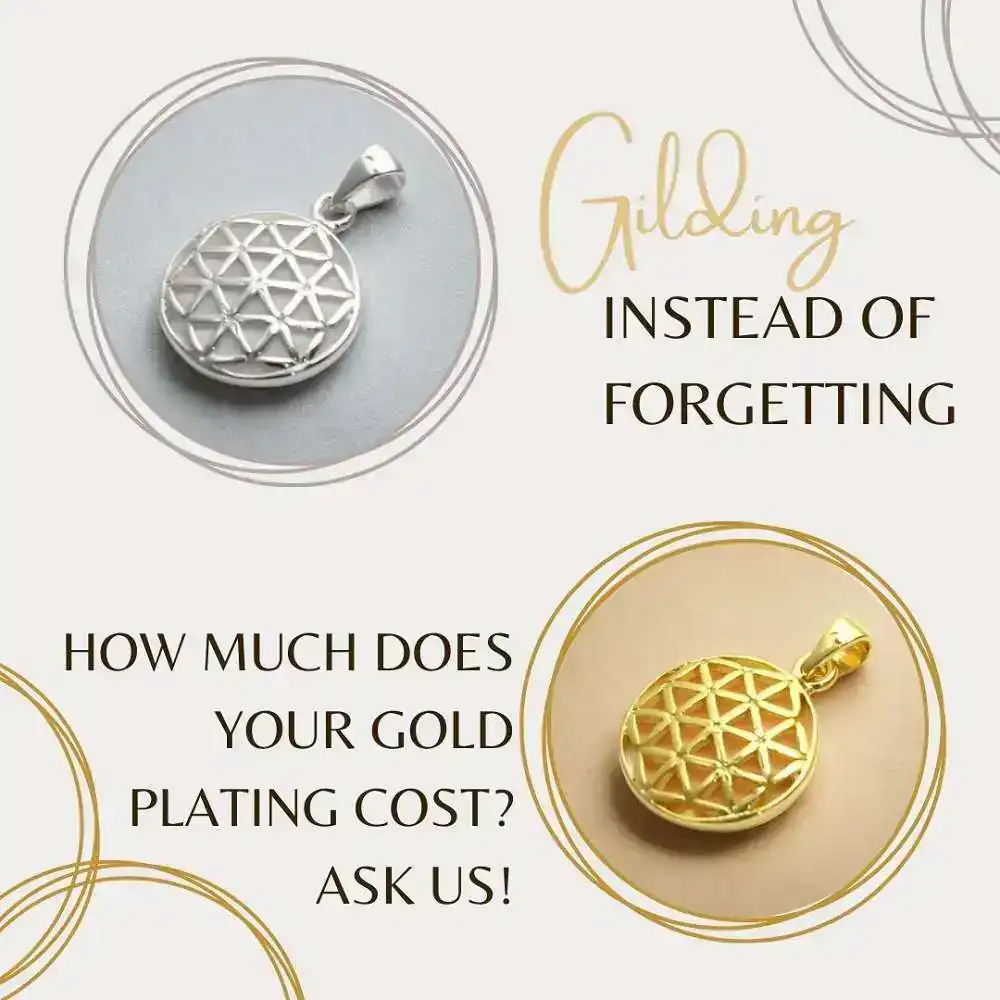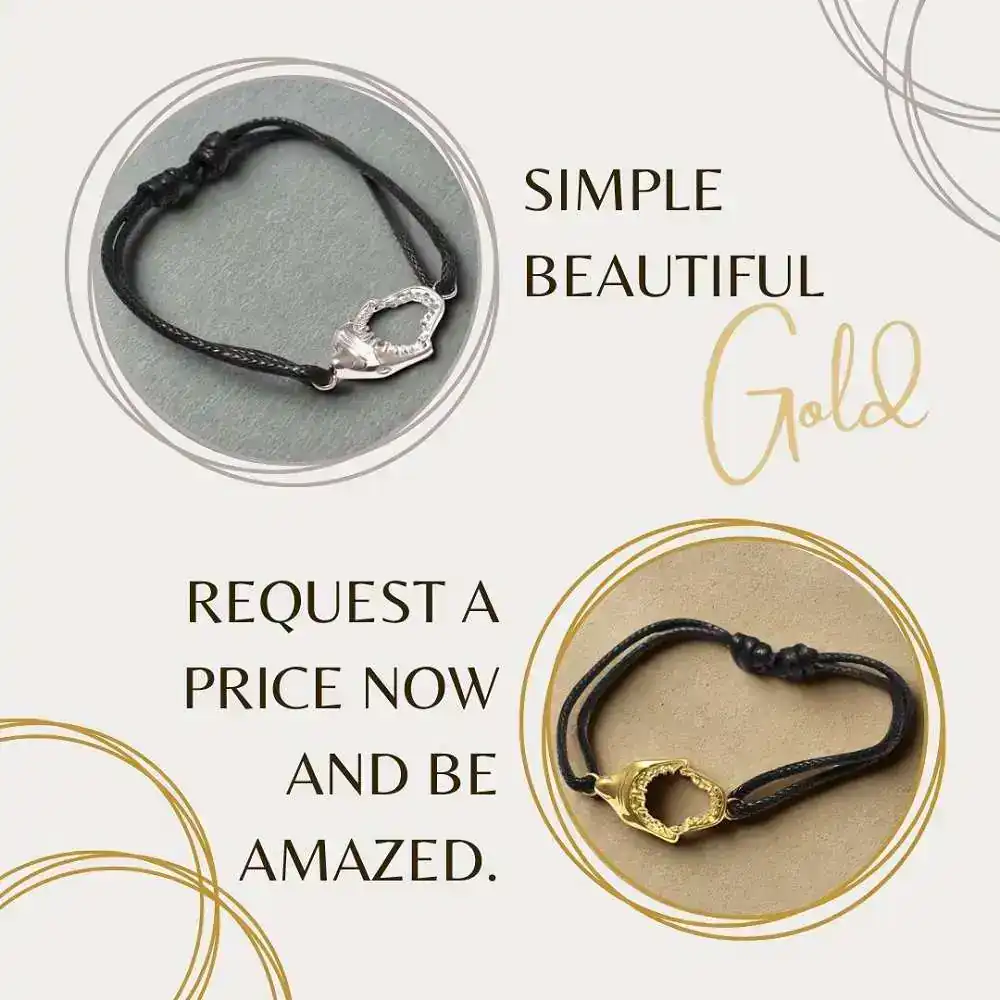Gold-plating silver jewelry - a refinement that pays off
Silver jewelry has inspired people for centuries with its timeless elegance. But although 925 sterling silver is one of the most popular jewelry metals, more and more jewelry lovers are turning to its gold-plated counterpart. Why is that? What are the advantages of gold-plating silver and how does the process work technically? In this blog article, you will find out everything you need to know if you want to have your silver gold-plated.
Request gold plating now!
Back to top
Why is silver ideal for gold plating?
 Silver, especially 925 sterling silver, is considered particularly suitable for high-quality gold plating as it offers a dense, smooth surface to which gold can optimally adhere. Compared to base metals such as brass or copper, silver reacts less with its surroundings, which minimizes corrosion under the gold layer and increases the durability of the coating.
Silver, especially 925 sterling silver, is considered particularly suitable for high-quality gold plating as it offers a dense, smooth surface to which gold can optimally adhere. Compared to base metals such as brass or copper, silver reacts less with its surroundings, which minimizes corrosion under the gold layer and increases the durability of the coating.
In addition, the high degree of purity of sterling silver ensures even adhesion, which guarantees a uniform, elegant finish. Gold can adhere less well to substrates such as stainless steel, as its surface is often too hard or too smooth for stable molecular bonds. Accordingly, gold plating on silver usually lasts longer than on stainless steel, brass or copper.
Back to top
The advantages: Elegant look, tarnish protection, gold shine at a low price
 Gold-plated silver jewelry combines aesthetics and functionality in an ideal way: The gold plating gives the piece of jewelry the warm, radiant hue of real gold. A tone that is traditionally associated with elegance, prosperity and timeless beauty.
Gold-plated silver jewelry combines aesthetics and functionality in an ideal way: The gold plating gives the piece of jewelry the warm, radiant hue of real gold. A tone that is traditionally associated with elegance, prosperity and timeless beauty.
The coating of high-alloy real gold creates a sophisticated look that looks almost indistinguishable from solid gold jewelry. At the same time, the gold acts as a natural barrier against oxygen and sulphur compounds, reliably protecting the underlying silver from the typical tarnishing.
Another advantage lies in the price-performance ratio: while solid gold jewelry is often very expensive due to the high material value, gold-plated silver jewelry remains significantly more affordable - with an almost identical effect. This means that high-quality designs can be created without compromising on appearance or wear quality.
According to a study by the Jewellery Industry Research Centre, gold-plated jewelry is up to 90% cheaper than its solid gold counterparts, while still being suitable for everyday wear and looking great (JIRC Report, 2020).
Back to top
Technical implementation: What happens during the electroplating of silver?
 Electroplating is the most commonly used method for refining silver jewelry. The piece of jewelry is immersed in an electrolytic gold bath and subjected to direct current. The gold is deposited evenly on the silver surface and forms a solid, adherent layer of gold. This method enables precise control of the layer thickness, which is essential for both intricate designs and durable coatings.
Electroplating is the most commonly used method for refining silver jewelry. The piece of jewelry is immersed in an electrolytic gold bath and subjected to direct current. The gold is deposited evenly on the silver surface and forms a solid, adherent layer of gold. This method enables precise control of the layer thickness, which is essential for both intricate designs and durable coatings.
A key advantage of electroplated gold plating is the high adhesive strength and even distribution of the gold particles. This creates a smooth, abrasion-resistant surface with an elegant sheen that also offers functional protection against oxidation and mechanical wear. The process is also gentle on the material: as no heat is used, delicate pieces of jewelry remain intact, making it ideal for silver as a base material.
| If you would like more details on what is important for gold plating, take a look at this blog article: Gold-plating jewelry – how it works and what you should look out for. |
Click here for the gold plating offer!
Back to top
Differences between yellow gold, rose gold and white gold
 The differences between yellow gold, rose gold and white gold lie in their alloy composition and physical properties, which have a direct impact on color, hardness and durability.
The differences between yellow gold, rose gold and white gold lie in their alloy composition and physical properties, which have a direct impact on color, hardness and durability.
Yellow gold typically consists of pure gold, silver and copper in balanced proportions, which creates the classic, warm coloring and ensures high corrosion resistance.
Rose gold contains a higher proportion of copper, which gives it its reddish tone, but also leads to a slightly higher hardness - at the same time, however, this copper content can be more susceptible to oxidation, which is why rose gold plating often does not last as long as comparable yellow gold plating.
White gold, on the other hand, is a gold alloy with additives such as palladium or silver, which provide the silvery-white hue. A white gold alloy is generally harder than a comparable yellow gold alloy and therefore offers increased abrasion resistance. However, the characteristic white color of white gold comes from the rhodium with which the white gold is additionally coated. This provides the radiant white surface and additional protection. Conversely, in the case of white gold plating, this means that the silver can simply be rhodium-plated to achieve the typical white gold look.
In terms of gold plating, this means that yellow gold plating is color-stable and particularly skin-friendly. Rose gold plating offers a fashionable, warm alternative, but requires more care to prevent oxidation. White gold coatings are uncommon for gold plating, as a rhodium coating can be used instead. This is characterized by high resistance and modern shine and requires occasional rhodium plating to refresh it.
Get your jewelry gold-plated now!Back to top
Care instructions for gold-plated silver: how to keep gold plating beautiful for a long time
 Proper care plays a decisive role in the durability of gold-plated silver jewelry. It is particularly important to avoid mechanical friction. Frequent wearing next to other pieces of jewelry, rough fabrics or placing them on hard surfaces can wear away the fine layer of gold.
Proper care plays a decisive role in the durability of gold-plated silver jewelry. It is particularly important to avoid mechanical friction. Frequent wearing next to other pieces of jewelry, rough fabrics or placing them on hard surfaces can wear away the fine layer of gold.
Contact with perfume, sweat, lotions or cleaning agents should also be avoided, as chemical substances can attack the gold plating and reduce the protective effect against corrosion.
Dry, dark storage - preferably in a soft cloth bag or an airtight plastic bag - protects against humidity and oxygen, which can lead to gradual oxidation of the silver under the gold coating. Although this oxidation is not immediately visible, it can impair the adhesion of the gold plating in the long term.
Regular, gentle cleaning with a soft microfiber cloth maintains the shine without damaging the coating. Aggressive polishing agents are unsuitable as they have an abrasive effect and can remove the gold coating. A silver polishing cloth should only be used if the gold plating has actually tarnished.
If you follow these simple care tips, you will be able to maintain the elegant look of your gold-plated jewelry for many years to come.
Back to top
Tips: Which pieces of jewelry are particularly suitable for gold plating?
 Not all pieces of silver jewelry are equally suitable for gold plating. The decisive factors are the structure, material mix and stress. Smooth, unlacquered pieces of jewelry without sensitive gemstone settings are particularly suitable, as the gold layer can adhere evenly and no reactions with glue, lacquer or porous stones occur.
Not all pieces of silver jewelry are equally suitable for gold plating. The decisive factors are the structure, material mix and stress. Smooth, unlacquered pieces of jewelry without sensitive gemstone settings are particularly suitable, as the gold layer can adhere evenly and no reactions with glue, lacquer or porous stones occur.
Pieces of jewelry with enamel, synthetic resin or open-pored gemstones such as turquoise or opal can be damaged during the electroplating process, which is why they should usually not be gold-plated or only very carefully.
The type of jewelry also influences its suitability for permanent gold-plating:
Rings are particularly exposed to frequent skin contact, friction and hand washing - a thicker layer of gold is recommended here for better durability.
Necklaces and earrings , on the other hand, are less exposed to mechanical stress and can retain their shine for a long time with thinner gold plating (if you take them off when showering or sleeping).
Bracelets are in the middle range and should be gold-plated to suit the design and clasp mechanism.
| You can find more information on gold plating thickness here: The right thickness for gold plating – why it shouldn't be nano gold plating . |
As a general rule, the simpler the design and the less daily wear and tear, the better the piece of jewelry can be gold-plated and permanently protected.
Start your gold-plating request here!Back to top
Sustainability: Turning old into new - gold-plated jewelry as an environmentally conscious alternative
 Gold-plating old silver jewelry is not only an aesthetic upgrade, but also an active contribution to sustainability. Instead of disposing of discarded pieces or buying new jewelry, existing jewelry can be upgraded and made wearable again through gold plating - this saves valuable resources and significantly reduces waste.
Gold-plating old silver jewelry is not only an aesthetic upgrade, but also an active contribution to sustainability. Instead of disposing of discarded pieces or buying new jewelry, existing jewelry can be upgraded and made wearable again through gold plating - this saves valuable resources and significantly reduces waste.
The recycling of silver also avoids the environmentally intensive process of metal mining, which is associated with high energy and water consumption.
Gold plating also extends the life of jewelry by effectively protecting the underlying silver from tarnishing. In this way, even heavily used favorite pieces retain their function and shine for years to come.
Especially memorabilia or heirlooms with sentimental value can be stylishly preserved in this way - and are not only given a second life thanks to the new layer of gold, but also an enhanced appearance.
The refinement of jewelry thus combines sustainability with emotion and design - entirely in the spirit of conscious, resource-conserving consumer behavior.
Back to top
Conclusion: Enhance your jewelry with style - have silver gold-plated now
 Gold-plating silver jewelry is more than just a visual upgrade - it combines elegance, functionality and sustainability.
Gold-plating silver jewelry is more than just a visual upgrade - it combines elegance, functionality and sustainability.
The galvanic gold coating reliably protects the silver from the typical tarnishing and makes the piece of jewelry more resistant to external influences. At the same time, it gives the jewelry an elegant golden sheen that is visually almost indistinguishable from solid gold - but at a fraction of the cost.
Choosing gold plating significantly extends the life of your silver jewelry. The gold layer acts like a protective coating against abrasion and corrosion - a practical advantage, especially for rings, chains or bracelets.
In addition, the desired style can be flexibly adapted: Whether classic yellow gold, delicate rose gold or modern white gold - the color of the gold plating can be chosen individually to adapt the piece of jewelry to current trends or personal preferences.
Last but not least, refinishing existing pieces of jewelry is an environmentally conscious alternative to buying new. It saves resources, avoids unnecessary waste and preserves intangible values.
So if you decide to have your silver jewelry gold-plated, we will be happy to make you a non-binding offer!
Do you want to have your jewelry gold-plated?
Request a quote now - professional, high-quality and individual.